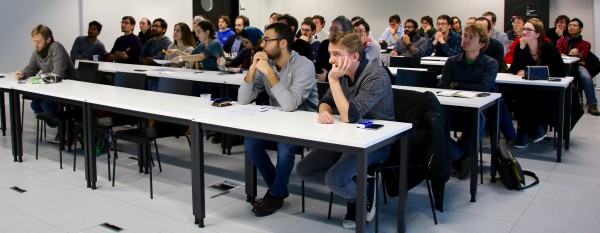MARVEL Junior Seminar — March 2019
The MARVEL Junior Seminars aim to intensify interactions between the MARVEL Junior scientists belonging to different research groups located at EPFL. The EPFL community interested in MARVEL research topics is very welcome to attend. We believe that these events will be central for establishing a vibrant community.
Each seminar consists of two presentations of 25 minutes each, allowing to present on a scientific question in depth, followed by time for discussion. The discussion is facilitated and timed by the chair.
Pizza is served at 11:45 in the MED hall (floor 0), and after the seminar at 13:30 you are cordially invited for coffee and dessert to continue discussion with the speakers.

MARVEL Junior Seminar Organizing Committee — Francesco Ambrosio, Davide Campi, Edgar Engel, Gloria Capano, Michele Pizzochero, Kun-Han Lin, Francesco Maresca and Patrick Mayor
Abstract — A self-consistent site-dependent DFT+U approach for defects in transition metal oxides
Chiara Ricca1, Iurii Timrov2, Matteo Cococcioni2, Sebastiaan P. Huber2, Nicola Marzari2, Ulrich Aschauer1
1 Department of Chemistry and Biochemistry, University of Bern
2 Theory and Simulation of Materials (THEOS), EPFL
Exploiting the interplay between ferroelectricity, magnetism, strain, and defects is a promising strategy to design transition metal oxides with new functionalities. DFT can be a powerful tool for material discovery, but advanced DFT methods are necessary to provide an accurate description of the electronic properties of correlated materials. Compared to hybrid functionals, DFT+U combines an adequate description of electron localization in these systems and a more affordable computational cost. However, the formation of defects in these materials induces local perturbations in the chemical environment of Hubbard sites around the defect that may not be properly described by applying a global U value on all sites as done in conventional DFT+U. For this reason, we propose a self-consistent site-dependent (SC-SD) DFT+U approach for calculations of defects in transition-metal oxides.
Here, U is treated as an intrinsic response property of the material and computed from first principles using density-functional perturbation theory. SC-SD U values are obtained starting from a DFT ground state by an iterative procedure that involves perturbing all inequivalent Hubbard sites followed by geometry relaxation with the determined U values until convergence of the geometry and U. Changes in U due to excess charge localization and lattice relaxation in defective structures are hence properly accounted for.
After discussing the approach, we highlight some results, showing that U values depend on the distance of the Hubbard site from the defect, its coordination number, its oxidation state, and on the magnetic properties of the material. This site-dependence is particularly important in the case of semiconductors, where filled localized defect states may form in the band gap, and strongly influence all properties related to defect energetics.
This methodology has been implemented within the AiiDA material’s informatics infrastructure using workflows to automate the SC-SD approach, as well as workflows for the DFT calculations of defects with the Quantum ESPRESSO package.
Abstract — Machine learning meets volcano plots: computational discovery of cross coupling catalysts
Stefan Heinen1, Benjamin Meyer2, Boodsarin Sawatlon2, Anatole von Lilienfeld1, Clémence Corminboeuf2
1 Institute of Physical Chemistry, University of Basel
2 Laboratory for Computational Molecular Design (LCMD), EPFL
The application of modern machine learning to challenges in atomistic simulation is gaining attraction. We present new machine learning models that can predict the energy of the oxidative addition process between a transition metal complex and a substrate for C–C cross-coupling reactions. In turn, this quantity can be used as a descriptor to estimate the activity of homogeneous catalysts using molecular volcano plots. The versatility of this approach is illustrated for vast libraries of organometallic catalysts based on Pt, Pd, Ni, Cu, Ag, and Au combined with 91 ligands. Out-of-sample machine learning predictions were made on a total of 18 062 compounds leading to 557 catalyst candidates falling into the ideal thermodynamic window. This number was further refined by searching for candidates with an estimated price lower than 10 US$ per mmol. The 37 catalyst finalists are dominated by palladium phosphine ligand combinations but also include the earth abundant transition metal (Cu) with less common ligands. Our results indicate that modern statistical learning techniques can be applied to the computational discovery of readily available and promising catalyst candidates.
Check the list of the next MARVEL Junior Seminars here.
Low-volume newsletters, targeted to the scientific and industrial communities.
Subscribe to our newsletter